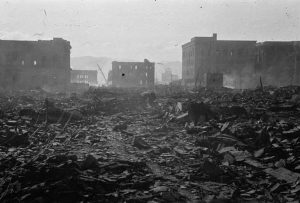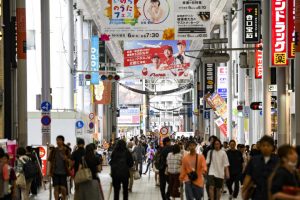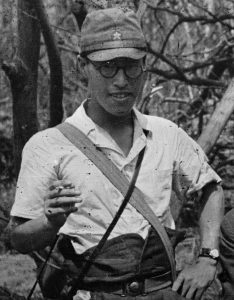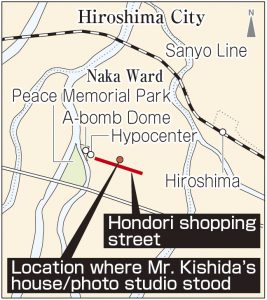Striving to fill voids in Hiroshima, evidence of victims remains 76 years after atomic bombing—Photos of A-bombing destruction, Part 1: Hondori shopping street devastation captured by Mitsugi Kishida
Dec. 5, 2021
by Kyosuke Mizukawa, Staff Writer
A-bombing photographs of the horror of Hiroshima’s atomic bombing have been introduced through A-bomb exhibits and photo anthologies, conveying to people in Japan and the rest of the world the devastation wrought by the atomic bombing as well as the inhumane nature of nuclear weapons. The role the photos play will continue to expand as the number of A-bomb survivors who share their bombing experiences with the public decreases with age. What message are the A-bombing photos, taken by those who experienced the atomic bombing firsthand, telling us now? The Chugoku Shimbun will carefully reexamine the iconic A-bomb photos and heretofore forgotten excerpts from personal notes written by the photographers, inquire of surviving family members, and reconsider the significance of the items.
On August 7, 1945, the Hondori shopping street, one of the busiest areas in Hiroshima (now part of the city’s Naka Ward), was destroyed in the previous day’s atomic bombing, with smoke from smoldering fires caused by the bombing still lingering in the air. Mitsugi Kishida grabbed a camera near the site where his home-cum-photo studio had once stood. The home was about 500 meters southeast of the hypocenter. Widespread charred remains of buildings around the site were still hot.
Mr. Kishida was then 29 years old. He had been to the Hondori area on August 6, and later described the miserable conditions in the aftermath of the bombing in a personal note. “It was hell on earth. People groaning, suffering in pain, and begging for help…” One night after August 6, the day he could not bring himself to snap his camera shutter, he took a photo near the remains of his home after a considerable internal struggle. His photo is said to have been the first to capture Hiroshima’s downtown after the atomic bombing.
Mr. Kishida started a photo studio business in 1942. As the war intensified, he served as a member of the Imperial Japanese Army’s Chugoku District Military Headquarters news team, which was located in the Hiroshima Castle.
In the morning of August 6, 1945, he was on military-related travel to the area of Yoshida-cho (now part of Akitakata City). When he witnessed the mushroom cloud rising in the sky, he headed back to Hiroshima. But his train stopped at the train station in the area of Hesaka (now part of Hiroshima’s Higashi Ward) because of fires that had broken out in Hiroshima City. Having made his way through a crowd of wounded who had fled to the outskirts of Hiroshima, he walked toward the city and entered the city center.
Worried that photos of victims would lead to loss of morale
Mr. Kishida carried around his camera, but “Instead of taking photos, the only thing I could do was help the victims drink water,” he wrote in his note. He found victims around the water tank used for fire prevention at the corner of the Hondori shopping street and rescued a woman immersed in the tank by lifting her out. Later, when he was asked about the reason why he did not take any photos at first, he responded that it was hard for him to take photos of the dead or wounded in such a pitiful state. He believed he should not, as a member of the military news team, weaken the morale of the people amid a war by taking tragic scenes of the bombing.
On the following day, however, he determined he had to “Convey the unprecedented destruction to future generations.” In addition to the Hondori area, he took several photos in other locations, including one overlooking the ruins from an emergency stairway at the Fukuya Department Store. Ultimately, he did not take any close-ups of faces of victims.
Like other survivors, starting around August 13, he suffered from a high fever and spent the next several months recuperating. He then rebuilt his photo studio in the Hondori area. In 1978, he formed a group called the Association of Photographers of the Atomic Bomb Destruction of Hiroshima, together with the late Yoshito Matsushige, former staff photographer for the Chugoku Shimbun, and others. In 1981, the group published a photo collection titled “The Moment of Hiroshima’s Destruction.” He died six years later at the age of 71.
For many years, 30 of Mr. Kishida’s negatives were stored in a bank safe-deposit box. In 2018, the negatives were donated to the Hiroshima Peace Memorial Museum, located in the city’s Naka Ward. Together with his father, Teppei Kishida, 44, Mr. Kishida’s grandson who lives in Suginami City, Tokyo, had taken over operations of his grandfather’s studio and entrusted the negatives to the museum in the hopes that they would help convey the memories of the atomic bombing to future generations.
Teppei has worked as a live cameraman in Tokyo for more than two decades, taking photos of artists’ live performances, including the performer Keisuke Kuwata. He had never heard about the background story of when his grandfather, who died when Teppei was a fourth-grade student in elementary school, took the photos after the atomic bombing directly from him. He said, “I only remember how gentle my grandfather was. If possible, I want to hear what he was thinking when he took the photos in those circumstances.” His desire to hear the story has grown year by year.
“A return to the past” must be avoided
One impetus for Teppei was the 2011 Great East Japan Earthquake. He came upon the idea that, by comparing his grandfather’s photos with the current landscape, the power of human beings to recover from difficult circumstances could be come into focus. In 2013, he took a panoramic photo of Hiroshima’s downtown area from the Fukuya Department Store, using the same composition as his grandfather had done years before. In August 2019, he also took a photo with the same composition as Mitsugi’s photo of the Hondori family photo studio. He uploaded the photos to the Hiroshima Prefecture members-only social media site “Hiroshima Daily Washira.”
Grandfather and grandson took cityscape photos taken from the exact same spot but with completely different results in terms of appearance. Teppei hopes that viewers, by comparing the two photos, not only understand Hiroshima’s recovery but also imagine a future that must be avoided. He said, “If war breaks out again and nuclear weapons were to be used, the world would return from our present existence that I captured with my camera to the catastrophic situation my grandfather’s photos captured.”
(Originally published on December 5, 2021)
A-bombing photographs of the horror of Hiroshima’s atomic bombing have been introduced through A-bomb exhibits and photo anthologies, conveying to people in Japan and the rest of the world the devastation wrought by the atomic bombing as well as the inhumane nature of nuclear weapons. The role the photos play will continue to expand as the number of A-bomb survivors who share their bombing experiences with the public decreases with age. What message are the A-bombing photos, taken by those who experienced the atomic bombing firsthand, telling us now? The Chugoku Shimbun will carefully reexamine the iconic A-bomb photos and heretofore forgotten excerpts from personal notes written by the photographers, inquire of surviving family members, and reconsider the significance of the items.
Unable to take photos of dead and wounded, he wrote “It was hell”
In memory of grandfather, grandson takes photos using same composition
On August 7, 1945, the Hondori shopping street, one of the busiest areas in Hiroshima (now part of the city’s Naka Ward), was destroyed in the previous day’s atomic bombing, with smoke from smoldering fires caused by the bombing still lingering in the air. Mitsugi Kishida grabbed a camera near the site where his home-cum-photo studio had once stood. The home was about 500 meters southeast of the hypocenter. Widespread charred remains of buildings around the site were still hot.
Mr. Kishida was then 29 years old. He had been to the Hondori area on August 6, and later described the miserable conditions in the aftermath of the bombing in a personal note. “It was hell on earth. People groaning, suffering in pain, and begging for help…” One night after August 6, the day he could not bring himself to snap his camera shutter, he took a photo near the remains of his home after a considerable internal struggle. His photo is said to have been the first to capture Hiroshima’s downtown after the atomic bombing.
Mr. Kishida started a photo studio business in 1942. As the war intensified, he served as a member of the Imperial Japanese Army’s Chugoku District Military Headquarters news team, which was located in the Hiroshima Castle.
In the morning of August 6, 1945, he was on military-related travel to the area of Yoshida-cho (now part of Akitakata City). When he witnessed the mushroom cloud rising in the sky, he headed back to Hiroshima. But his train stopped at the train station in the area of Hesaka (now part of Hiroshima’s Higashi Ward) because of fires that had broken out in Hiroshima City. Having made his way through a crowd of wounded who had fled to the outskirts of Hiroshima, he walked toward the city and entered the city center.
Worried that photos of victims would lead to loss of morale
Mr. Kishida carried around his camera, but “Instead of taking photos, the only thing I could do was help the victims drink water,” he wrote in his note. He found victims around the water tank used for fire prevention at the corner of the Hondori shopping street and rescued a woman immersed in the tank by lifting her out. Later, when he was asked about the reason why he did not take any photos at first, he responded that it was hard for him to take photos of the dead or wounded in such a pitiful state. He believed he should not, as a member of the military news team, weaken the morale of the people amid a war by taking tragic scenes of the bombing.
On the following day, however, he determined he had to “Convey the unprecedented destruction to future generations.” In addition to the Hondori area, he took several photos in other locations, including one overlooking the ruins from an emergency stairway at the Fukuya Department Store. Ultimately, he did not take any close-ups of faces of victims.
Like other survivors, starting around August 13, he suffered from a high fever and spent the next several months recuperating. He then rebuilt his photo studio in the Hondori area. In 1978, he formed a group called the Association of Photographers of the Atomic Bomb Destruction of Hiroshima, together with the late Yoshito Matsushige, former staff photographer for the Chugoku Shimbun, and others. In 1981, the group published a photo collection titled “The Moment of Hiroshima’s Destruction.” He died six years later at the age of 71.
For many years, 30 of Mr. Kishida’s negatives were stored in a bank safe-deposit box. In 2018, the negatives were donated to the Hiroshima Peace Memorial Museum, located in the city’s Naka Ward. Together with his father, Teppei Kishida, 44, Mr. Kishida’s grandson who lives in Suginami City, Tokyo, had taken over operations of his grandfather’s studio and entrusted the negatives to the museum in the hopes that they would help convey the memories of the atomic bombing to future generations.
Teppei has worked as a live cameraman in Tokyo for more than two decades, taking photos of artists’ live performances, including the performer Keisuke Kuwata. He had never heard about the background story of when his grandfather, who died when Teppei was a fourth-grade student in elementary school, took the photos after the atomic bombing directly from him. He said, “I only remember how gentle my grandfather was. If possible, I want to hear what he was thinking when he took the photos in those circumstances.” His desire to hear the story has grown year by year.
“A return to the past” must be avoided
One impetus for Teppei was the 2011 Great East Japan Earthquake. He came upon the idea that, by comparing his grandfather’s photos with the current landscape, the power of human beings to recover from difficult circumstances could be come into focus. In 2013, he took a panoramic photo of Hiroshima’s downtown area from the Fukuya Department Store, using the same composition as his grandfather had done years before. In August 2019, he also took a photo with the same composition as Mitsugi’s photo of the Hondori family photo studio. He uploaded the photos to the Hiroshima Prefecture members-only social media site “Hiroshima Daily Washira.”
Grandfather and grandson took cityscape photos taken from the exact same spot but with completely different results in terms of appearance. Teppei hopes that viewers, by comparing the two photos, not only understand Hiroshima’s recovery but also imagine a future that must be avoided. He said, “If war breaks out again and nuclear weapons were to be used, the world would return from our present existence that I captured with my camera to the catastrophic situation my grandfather’s photos captured.”
(Originally published on December 5, 2021)











